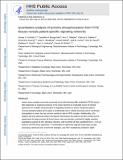Quantitative analysis of tyrosine phosphorylation from FFPE tissues reveals patient-specific signaling networks
Author(s)
Kohale, Ishwar N; Burgenske, Danielle M; Mladek, Ann C; Bakken, Katrina K; Kuang, Jenevieve; Boughey, Judy C; Wang, Liewei; Carter, Jodi M; Haura, Eric B; Goetz, Matthew P; Sarkaria, Jann N; White, Forest M; ... Show more Show less
DownloadAccepted version (2.499Mb)
Open Access Policy
Open Access Policy
Creative Commons Attribution-Noncommercial-Share Alike
Terms of use
Metadata
Show full item recordAbstract
Human tissue samples commonly preserved as formalin-fixed paraffin-embedded (FFPE) tissues after diagnostic or surgical procedures in the clinic represent an invaluable source of clinical specimens for in-depth characterization of signaling networks to assess therapeutic options. Tyrosine phosphorylation (pTyr) plays a fundamental role in cellular processes and is commonly dysregulated in cancer but has not been studied to date in FFPE samples. In addition, pTyr analysis that may otherwise inform therapeutic interventions for patients has been limited by the requirement for large amounts of frozen tissue. Here we describe a method for highly sensitive, quantitative analysis of pTyr signaling networks, with hundreds of sites quantified from one to two 10-μm sections of FFPE tissue specimens. A combination of optimized magnetic bead-based sample processing, optimized pTyr enrichment strategies, and tandem mass tag multiplexing enabled in-depth coverage of pTyr signaling networks from small amounts of input material. Phosphotyrosine profiles of flash-frozen and FFPE tissues derived from the same tumors suggested that FFPE tissues preserve pTyr signaling characteristics in patient-derived xenografts and archived clinical specimens. pTyr analysis of FFPE tissue sections from breast cancer tumors as well as lung cancer tumors highlighted patient-specific oncogenic driving kinases, indicating potential targeted therapies for each patient. These data suggest the capability for direct translational insight from pTyr analysis of small amounts of FFPE tumor tissue specimens. SIGNIFICANCE: This study reports a highly sensitive method utilizing FFPE tissues to identify dysregulated signaling networks in patient tumors, opening the door for direct translational insights from FFPE tumor tissue banks in hospitals.
Date issued
2021Department
Massachusetts Institute of Technology. Department of Biological Engineering; Koch Institute for Integrative Cancer Research at MIT; Center for Precision Cancer MedicineJournal
Cancer Research
Publisher
American Association for Cancer Research (AACR)